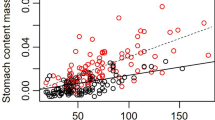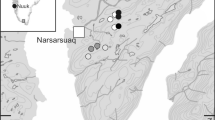Summary
Mean daily food consumption and total lifetime food consumption of the spider,Nephila clavata, were estimated in natural populations. Daily food consumption in the late adult stage was 27–150 mg wet weight, which was nearly equivalent or slightly larger than that in other large web-building spiders. Considerable variation in food consumption was found among habitats or years. The largest variation among habitats in the same year was 7 and 5 fold for daily and lifetime consumption, respectively, while that among years in the same habitat was 3.5 and 2.5 for daily and lifetime consumption, respectively. Feeding conditions evaluated from the food consumption per body weight of spiders declined during the period from mid-July to mid-September in almost all the populations, which suggested that they faced to severe food limitation in this period.
Similar content being viewed by others
References
Higashi, K. (1973) Estimation of the food consumption for some species of dragonflies I. Estimation by observation for the frequency of feeding flights of dragonflies (in Japanese).Rep. Ebino Biol. Lab., Kyushu Univ.1: 119–129.
Humphreys, W. F. (1975) The food consumption of a wolf spider,Geolycosa godeffroyi (Araneae: Lycosidae). In the Australian capital territory.Oecologia 18: 343–358.
Kajak, A. (1967) Productivity of some populations of web spiders. 807–820. In K. Petrusewicz (ed)Secondary productivity of terrestrial ecosystems. Panstwowe Wydawn, Warsawa.
Kiritani, K., S. Kawahara, T. Sasaba and F. Nakasuji (1972) Quantitative evaluation of predation by spiders on the green rice leafhopper,Nephotettix cincticeps Uhler, by a sight-count method.Res. Popul. Ecol. 13: 187–200.
Matsura, T. and S. Nagai (1983) Estimation of prey consumption of a mantid,Paratenodera angustipennis (S.) in a natural habitat.Res. Popul. Ecol. 25: 298–308.
Matsura, T. (1986) The feeding ecology of the pit-making ant lion larva,Myrmeleon bore: Feeding rate and species composition of prey in a habitat.Ecol. Res. 1: 15–24.
Miyashita, T. (1986) Growth, egg production and population density of the spider,Nephila clavata in relation to food conditions in the field.Res. Popul. Ecol. 28: 135–149.
Miyashita, T. (1990) Decreased reproductive rate of the spider,Nephila clavata, inhabiting small woodlands in urban areas.Ecol. Res. 5: 341–351.
Miyashita, T. (1991) Direct evidence of food limitation for growth rate and body size in the spiderNephila clavata.Acta Arachnol. 40: 17–21.
Murdoch, W. W. (1971) The developmental response of predators to changes in prey density. Ecology52: 132–137.
Nakamura, K. (1972) The ingestion in wolf spiders II. The expression of hunger and amount of ingestion in relation to spider’s hunger.Res. Popul. Ecol. 14: 82–96.
Nyffeler, M. and G. Benz (1988) Feeding ecology and predatory importance of wolf spiders (Pardosa spp.) (Araneae, Lycosidae) in winter wheat fields.J. Appl. Ent. 106: 123–134.
Nyffeler, M. and R. G. Breene (1990) Evidence of low daily food consumption by wolf spiders in meadow and comparison with other cursorial hunters.J. Appl. Ent.,110: 73–81.
Riechert, S. E. and C. R. Tracy (1975) Thermal balance and prey availability: Bases for a model relating web-site characteristics to spider reproductive success.Ecology,56: 265–284.
Robinson, M. H. and B. Robinson (1970) Prey caught by a sample population of the spiderArgiope argentata (Araneae: Araneidae) in Panama: a year’s census data.Zool. J. Linn. Soc. 49: 345–358.
Santana, M., W. G. Eberhard, G. Bassey, K. N. Prestwich and R. D. Briceno (1990) Low predation rates in the field by the tropical spiderTengella radiata (Araneae: Tengellidae).Biotropica,22: 305–309.
Spiller, D.A. and T.W. Schoener (1988) An experimental study of the effect of lizards on web-spider communities.Ecol. Monographs,58: 57–77.
Tanaka, K. (1991) Food consumption and diet composition of the web-building spiderAgelena limbata in two habitats.Oecologia 86: 8–15.
Wise, D. H. (1979) Effects of an experimental increase in prey abundance upon the reproductive rates of two orb- weaving spider species (Araneae: Araneidae).Oecologia 41: 289–300.
Author information
Authors and Affiliations
Rights and permissions
About this article
Cite this article
Miyashita, T. Variability in food consumption rate of natural populations in the spider,Nephila clavata . Res Popul Ecol 34, 15–28 (1992). https://doi.org/10.1007/BF02513519
Issue Date:
DOI: https://doi.org/10.1007/BF02513519




